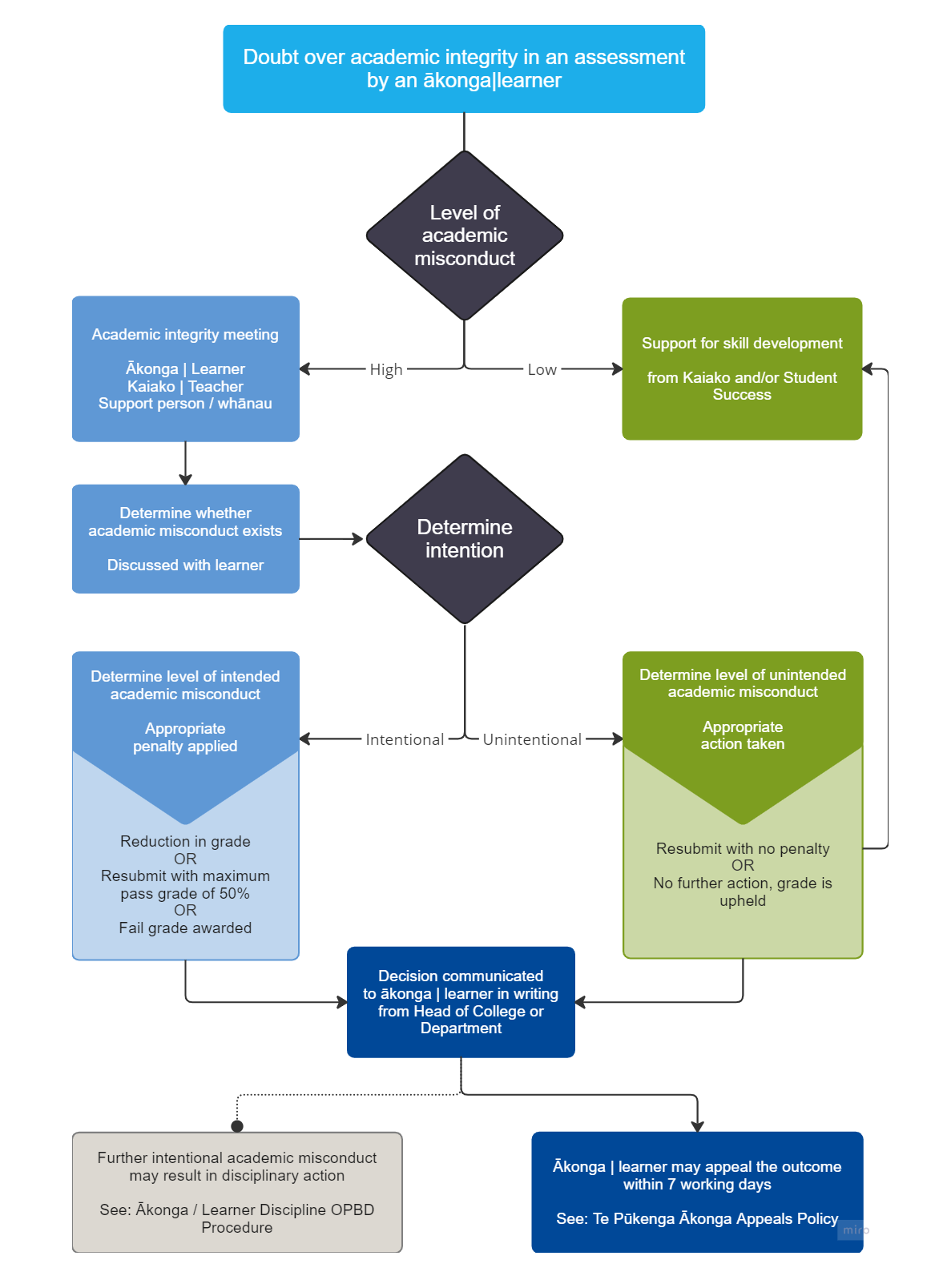Academic integrity
Academic integrity means being open and honest in your studies.
What is academic integrity?
Academic integrity means being open and honest in your studies. It also involves trust, fairness, respect, and taking accountability for one’s actions. All work you produce must be your own, unless you have stated you have taken the information from someone else. Academic integrity is the responsibility of both ākonga/learner and kaiako/teacher.
If you have any questions related to academic integrity after reading this page, please contact your kaiako/teacher.
What is academic misconduct?
Misconduct may be intentional or unintentional. Where it is unintentional, we will support you to learn new academic integrity skills.
Academic misconduct is dishonest behaviour related to your learning and assessment.
What does academic misconduct look like?
Examples of academic misconduct might include:
Using someone else's work or ideas without giving credit.
Example:
Copying text from a website into your essay without mentioning where it came from.
Paying or asking someone to do your work.
Example:
Hiring a service to write your essay and then submitting it as if you wrote it. This is an offence under the Education and Training Act 2020 (Section 393).
Using things you are not allowed to use or getting help without permission during a test or assignment.
Example:
Using a hidden cheat sheet during a test or copying from a friend's paper.
Using AI tools to do your assignments without permission or without saying you used them.
Example:
Using ChatGPT to write parts of your essay without mentioning it.
Making up information or citations.
Example:
Inventing data for a research paper instead of doing the actual research.
Working with someone else in a way that is not allowed to complete an assignment or exam.
Example:
Sharing answers for an assignment that is supposed to be done alone.
Submitting the same or very similar work for different courses or different iterations of the same course without permission.
Example:
Turning in the same essay for two different classes without telling your kaiako/teachers. Turning in an essay for the same course, but in a different year (if they had failed the first time).
Giving false information to your kaiako/teachers about your work.
Example:
Lying about a family emergency to get more time to finish an assignment.
Intentionally harming someone else's work.
Example:
Damaging another ākonga/learner’s project to stop them from finishing it.
How do I avoid plagarism?
Keep records
Keep a record of the information sources you are using so you can reference them in your work.
Referencing is a system used to acknowledge the sources of information you have used in your assignment. You do this by including your sources and listing all resources you have used in writing your assignments.
Spot the plagiarism
In order to avoid plagiarism, you have to recognise it. Watch the video below to learn the types of plagiarism.
Still not sure?
If you think that the boundaries between research and plagiarism can be ambiguous, it may help you to refer to the Policy and procedures section below and clarify any points of doubt with your kaiako/teacher before submitting work.
How do I use AI appropriately?
Using AI tools for your studies can fall into appropriate or inappropriate usage. You need to be aware of what is appropriate use, and what the issues/risks might be if you do use them, particularly for generative AI (GenAI) tools. The page below provides more information about appropriate use of AI tools.
What happens if I don’t uphold academic integrity?
If the breach is of low level, your kaiako/teacher or Student Success will simply support you to develop your skills. There will be no further action.
Low level misconduct might include:
-
Not formatting quotations correctly
-
Using too many quotations, so there is not enough of your own work
-
Not referencing in the correct format
-
Accidentally leaving sources off your reference list
Higher level misconduct
If the breach is more serious (e.g. some of the examples described in the Academic Misconduct above), your kaiako/teacher will have a meeting with you to discuss it.
We understand that misconduct may be intentional or unintentional. In the cases where it is unintentional, we will support you to learn new academic integrity skills. If it is intentional, a penalty may be applied, depending on the level of misconduct.
You will be notified of the outcome and the actions or penalty. You can appeal the decision if you disagree with the outcome.
The process is outlined below.

Preparing for a conversation with your kaiako/teacher
The first conversation is simply to discuss the academic integrity issue and hear from you about what happened. This first conversation is not a disciplinary meeting.
Your kaiako/teacher will advise you in advance of what the conversation is about.
What to bring
Bring with you any evidence which will support you. Depending on what the conversation is about, this might include:
-
Your assignment
-
Any drafts or previous versions of your assignment
-
Where you got your information and references from
-
The device(s) you were working on
-
Tickets or receipts showing when and where you travelled
-
Your AI prompts (as a screenshot, or show them on your computer)
-
Medical certificate or communication from your doctor
-
Anything else you think is important
-
Support people
You are entitled, and welcome, to bring a support person or your whānau|family with you.
After the conversation, you may be referred to Student Success who can support you with new academic skills.
Policies and procedures
References
Attributions
Hero image: Black and white board by David Bartus. Licensed under a Pexels.com licence.
Writing in a notebook by John Diez. Licensed under a Pexels.com licence.



